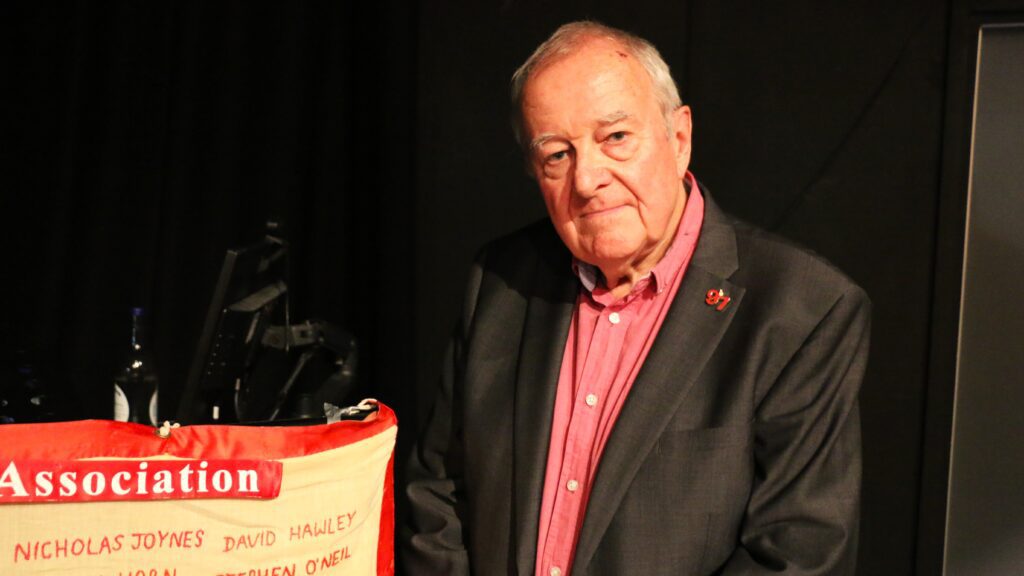Terence Davies, who has died at the age of 77, was a key figure in British and European cinema. The Liverpool-born director extended the formal possibilities of film, and had a unique capacity for depicting memory and personal history.
Much of Davies’ early work was directly informed by his difficult childhood in Liverpool, his relationship with his father, Irish Catholicism and a complicated adolescence. He discovered his homosexuality as a teenager, and in his work attempts to deal with the profound sense of shame and guilt this caused.
Here are four films that show the director dealing directly with this history, while also charting the development of his distinctive, very personal style.
1. Distant Voices, Still Lives (1988)
The director’s breakthrough came in 1988 with the release of Distant Voices, Still Lives, which tells the story of one working class family’s life in post-war Liverpool. The film was originally two short pieces made two years apart, which were later combined.
Told elliptically with often only sparing narrative information, the film is a series of vignettes that observe everyday life in what would become Davies’ signature “painterly” and reflective manner.
The central tension emerges from the family’s relationship with their violent and abusive father, played by Pete Postlethwaite. His explosive and unpredictable temper colours the first section of the film, before his death in the second section sees the family moving tentatively but hopefully into the 1950s.
Distant Voices, Still Lives is not only an excellent example of the formal styling that would come to characterise Davies’ work, but also the key role that music plays throughout his films. Snippets of contemporary song are often used to link otherwise seemingly unrelated moments and memories. Davies continued to use these audio bridges throughout his career.
2. The Long Day Closes (1992)
This Palme d’Or-nominated film tells the story of Bud, a shy 12-year-old boy who lives with his mother and sisters and uses the cinema to escape the grey drudgery of his city.
The film also reflects on Bud’s developing sense of his own homosexuality and the shame that accompanies this realisation. Through it, Bud becomes a figure of difference and finds himself set apart from the world.
The Long Day Closes is a companion piece to Distant Voices, Still Lives in its focus on family life in Liverpool. It contains similarly autobiographical and poetic content, while also deepening Davies’ aesthetic style. In one memorable sequence, the action sweeps, with a bird’s eye view, between the city’s cinema, church and school – the three key spaces of little Bud’s life.
3. The Neon Bible (1995)
Biography, memory and history are central to all of Davies work, even those that exist outside the geography of Liverpool and the era of the 1940s. In this way, The Neon Bible can be understood as an act of deflected autobiography.
Adapted from the 1989 John Kennedy Toole novel of the same name, the film’s protagonist – 15-year-old David – reflects via voiceover and flashback on his troubled upbringing in Georgia, his abusive and then absent father, and the key role that strong but often unreliable women played in his life.
Davies dismissed The Neon Bible after its release as a creative failure. But he also acknowledged its importance in the production of his next film, The House of Mirth (2000). However, the film is still absolutely worth a viewing – particularly for Gina Rowland’s performance as David’s Aunt Mae.
4. Of Time and the City (2009)
Arguably Davies crowning work, Of Time and the City marked a late career resurgence for the director. Thanks to the film’s critical success, he continued to produce work steadily in the final decade of his life.
The film looks back on the Liverpool in which he grew up, and is made from a tapestry of different sounds and images. Davies used fragments of music, poetry, still photography, news reels and cinema to create a kaleidoscope of personal and cultural memories.
There are images of women washing windows and newsreel footage of the Beatles, narrated in Davies’ own, unmistakable, sardonic tone. Of Time and the City reflects both Davies’ keenly ironic take on working class life and its pretensions, and also the grandeur and spectacle he sought and found in the everyday. As such, it offers another poetic, rhythmical, sensory entry into Davies’ canon.
Matthew Smith, Lecturer in Film, Media & Television, Edge Hill University
This article is republished from The Conversation under a Creative Commons license. Read the original article.
October 16, 2023



